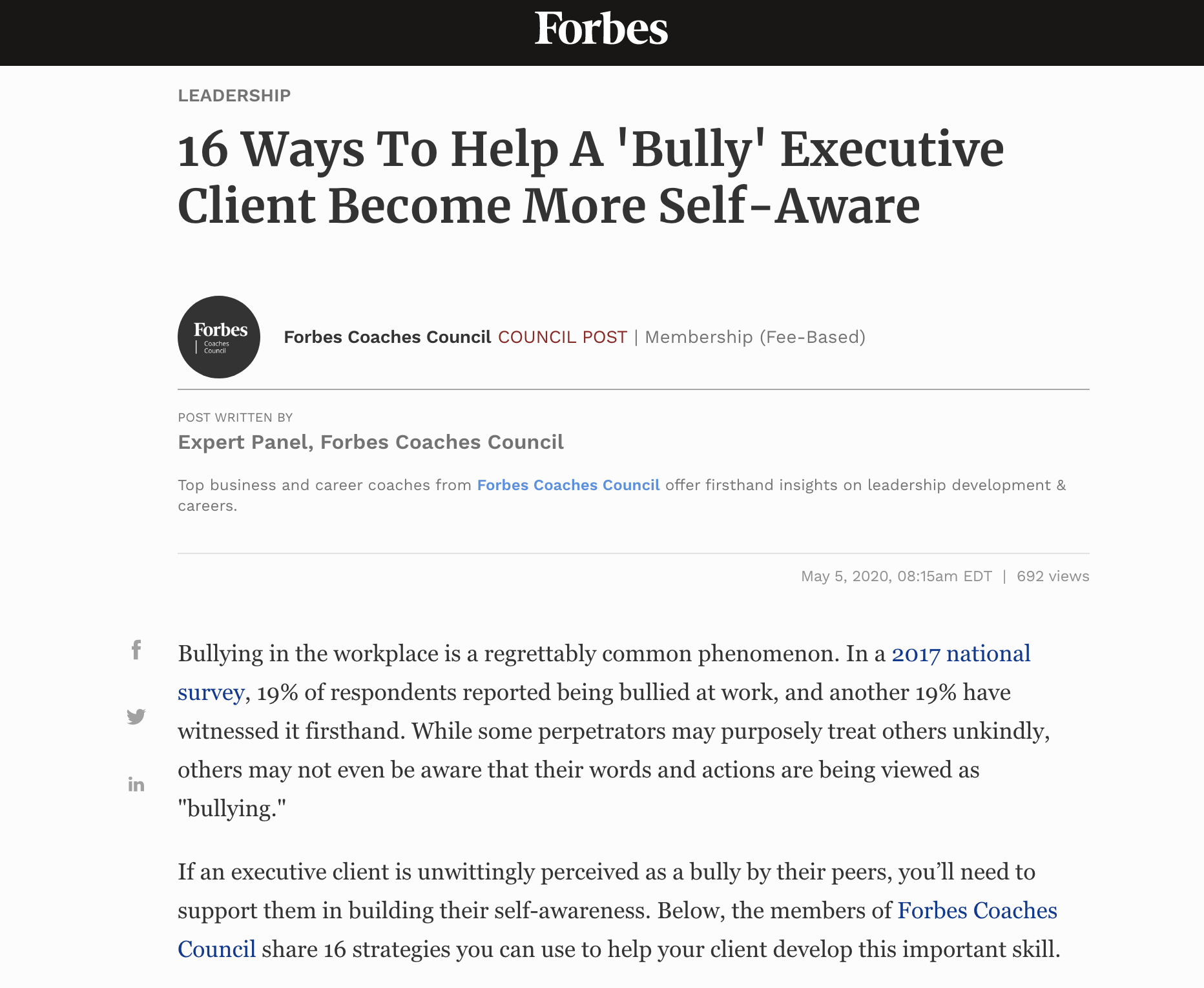Bullying in the workplace is a regrettably common phenomenon. In a 2017 national survey, 19% of respondents reported being bullied at work, and another 19% have witnessed it firsthand. While some perpetrators may purposely treat others unkindly, others may not even be aware that their words and actions are being viewed as “bullying.”
If an executive client is unwittingly perceived as a bully by their peers, you’ll need to support them in building their self-awareness. Below, the members of Forbes Coaches Council share 16 strategies you can use to help your client develop this important skill.
1. Have Them Choose One Or Two Peers To Offer Honest Feedback
The client could choose one or two peers who are most likely to give honest feedback if asked. It will be necessary for the client to be vulnerable and admit they are trying to improve relationships at work so that peers feel comfortable sharing. The client should be specific: “What is one thing I could change to improve how I communicate?” “What can I do to be sure I hear everyone’s ideas?” – Susan Shirley, Global View Leadership
2. Use The Active Imagination Technique
Carl Jung’s active imagination technique helps leaders explore their inner world and learn more about themselves. Insights gained in active imagination tend to expand one’s view by revealing multiple lenses to an issue. They challenge assumptions, making room for new understanding and greater objectivity. Deep self-work reveals the gaps between how others experience us and our best intentions. – La’Wana Harris, La’Wana Harris Inc.
Forbes Coaches Council is an invitation-only community for leading business and career coaches. Do I qualify?
3. Encourage Them To Read The Room
Often executives struggle to recognize the impact they’re having in real time, thereby missing an opportunity to adjust an approach that could be seen as bullying. To help, executives could tune in more to the data in the room. It is important to pay attention to what colleagues are saying, but it is just as important to pay attention to how they’re saying it and what they’re not saying. – Ryan Lahti, OrgLeader
4. Reframe Feedback As A Gift
The best way to increase self-awareness is to obtain feedback from peers either by having a coach interview key stakeholders or have the client sincerely ask others for feedback on their impact. By getting examples of how and when peers felt bullied, they can start to obtain the context they did not have. This feedback is critical to enable clients to be more effective and more successfully influence others. – Rochelle Cooper, Success Leaders
5. Conduct A 360 Assessment
A 360 assessment is a great way to gain insight into how you are showing up that benefits both the leaders and their teams. These assessments allow team members, peers and direct management to share their perspectives about how they interact with you and their perceptions of your leadership style and impact. However, make sure you are ready to accept honest feedback with a mindset of development and growth. – Tonya Echols, Vigere
6. Introduce Them To The Concept Of Microaggression
When given the chance to be in power, “unaware” leaders tend to exercise the influence of this power by bullying others. Since bullying is a form of microaggression, the first thing I would do is to make my client aware of the concept of microaggression and give them examples of how it works in the workplace. With this increase in self-awareness and self-control, the act of bullying may be controlled. – Abraham Khoureis, Dr. Abraham Khoureis
7. Remind Them Of The Long-Term Cost
Bullies are often control freaks and justify their words and actions by pointing to results. When they realize that steamrolling their staff may achieve short-term gains or objectives, but the cost is respect for themselves as leaders, they can shift their understanding (and self-awareness) of the impact their behavior has on their personal brand (play to ego) and longer-term success. – Joanne Heyman, Heyman Partners
8. Bridge The Disconnect Between Perceptions
When a leader believes their words were well-received but team members walk away feeling bullied, the disconnect is not in how the leader or the team member feels that conversation went—it’s in the perception each one has. When we actually ask questions to clarify and we follow up with compassion, it takes away much of the perception of bullying and creates honest conversation. – Jen Croneberger, JLynne Consulting Group
9. Go Through The Johari Window Exercise
While there are many assessments that can help an executive “hold up the mirror” and take a critical look at themselves, one simple exercise I use again and again is the Johari Window. The Johari Window is a simple matrix with “known/unknown to self” on one side and “known/unknown to others” on the other. This helps individuals better understand their relationships and reduce their blind spots. – Jonathan H. Westover, Ph.D, Utah Valley University & Human Capital Innovations, LLC
10. Suggest Meditation
If we’re honest, we’ve all been a bully at times. When we get a gut-alert that tells us something is not as we want it to be, we can often react. Sometimes we push and force people down the path we deem right. Other times, we become passive aggressive. Both styles of control can feel like bullying. But when we meditate and increase our gut intelligence (GQ), we respond effectively to situations. – Susan K. Wehrley, BIZremedies
11. Invite Them To Self-Evaluate Victim Versus Bully Behaviors
Executives don’t take such feedback lightly. Despite their defending mechanisms, I invite them to conduct an experiment. I suggest measuring what bullying at work is by having them list down the emotions and behaviors of a victim and a bully. Then I ask them to self-evaluate both. Often they see themselves as victims. Then we talk about what they do when they feel cornered. Any bully behaviors? I usually hear “yes.” – Inga Bielińska, Inga Arianna Bielinska Coaching Consulting Mentoring
12. Ask Them To Write Down Their Point Of View
I would ask them to describe, in writing, events that have had negative outcomes or were filled with strife. Writing down those events from their point of view helps me see how they perceived the situation. Then and only then do I start asking questions or pointing out others’ possible reasons for reactions and responses. If they ask questions and want to improve, then we have a foundation. – John M. O’Connor, Career Pro Inc.
13. Look At The Intent Versus Impact Together
Bullying has negative effects on individuals, teams, engagement, creativity and retention. Working with a client to help them distinguish between their intent and impact is key before addressing the issue of behavior change. Ask, “What impact are you having on your team?” followed by, “How is your impact different from your intent?” This allows the client to explore the gap between intent and impact. – Palena Neale, Ph.D, unabridged
14. Define The Line Between Perceived Assertiveness And Aggression
Most leaders are not keen on altering their communication style to cater to others. I explain that there is a fine line between being perceived as assertive or aggressive, but both project strength and commitment. The trigger for stepping over the line is usually a knee-jerk reaction, coupled with the frustration of a “can-do” attitude. Taking a breath before responding helps to break the habit. – Paul Geiger, Public Speaking Advantage
15. Observe Their Day-To-Day Activities
Working with an executive in a coaching relationship, I want to observe them throughout their day-to-day activities. I essentially become their shadow for a week in everything but their most private discussions. This way, I witness not only what they do, but also why they do it. Then, I can not only explain their behavior, but also show them why it happens, helping them self-manage their actions. – John Knotts, Crosscutter Enterprises
16. Illustrate The Situation Without Directly Naming Them
Sometimes people who are dominating characters struggle to see or take responsibility for their actions. Sometimes it’s really powerful to illustrate the scenario to them, but using different names, and ask them what they think and how they would handle it. Listen and stay minimal. Once they reverse their thoughts, go on to explain that the situation is actually regarding them. – Rebecca Patterson, Rebecca Patterson


